Going Nuts for Nutcrackers
by Bob Brooke
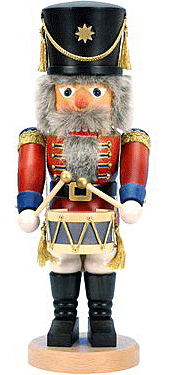 Lots
of people have admired German nutcrackers over the years and many
collect them. But few probably know that nutcrackers have been a part of
Christmas ever since the first one appeared in human form in the 17th
century. For Volker Fuchtner, making nutcrackers has been a family
business ever since his great-great grandfather, Wilhelm Friedrich
Fuchtner, created the classic wooden nutcracker in Germany's Erzgebirge
region. Lots
of people have admired German nutcrackers over the years and many
collect them. But few probably know that nutcrackers have been a part of
Christmas ever since the first one appeared in human form in the 17th
century. For Volker Fuchtner, making nutcrackers has been a family
business ever since his great-great grandfather, Wilhelm Friedrich
Fuchtner, created the classic wooden nutcracker in Germany's Erzgebirge
region.
For Fuchtner, making nutcrackers is still his family’s main business.
He’s a traditionalist and doesn’t foresee his company making anything
other than the traditional forms. He’s
convinced that his son won't produce any “Uncle Sams” when he takes over
one day. Unlike his competition, two non-Erzgebirge firms Steinbach and
Ulbricht. Neither have any qualms about making nutcrackers of Uncle Sam,
Santa Claus, Abraham Lincoln, Sherlock Holmes and other characters dear
to the hearts of the huge American market.
The Beginnings
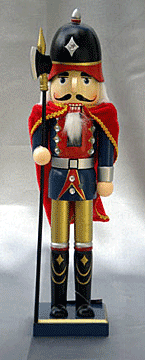 The classic nutcrackers usually stand 14 to 18 inches high and
take the form of a brightly painted king, soldier or some other
stern authority figure with huge painted teeth, an upward
curling moustache and a nut cracking mouth that reaches to his
waist when open. The classic nutcrackers usually stand 14 to 18 inches high and
take the form of a brightly painted king, soldier or some other
stern authority figure with huge painted teeth, an upward
curling moustache and a nut cracking mouth that reaches to his
waist when open.
The Erzgebirge is a range of low, forested hills that form the
border between the Czech Republic and the German state of
Saxony. Seiffen, which somehow managed to keep the woodworking
tradition alive during the days of communist occupation, is its
main town. It has more than 100 workshops, mainly small family
ones, in which townspeople make the nutcrackers and other items
of wooden folk art. There are also huge replicas of the
nutcrackers and other wooden figures all over town, and visits
to Seiffen at Christmas are special.
Mining used to be the main industry in the Erzgebirge—the name
translates as "Ore Mountains"—but the silver, iron, tin and
nickel eventually gave out. Woodworking then became a logical
occupation for the people, since the region had abundant wood
and rushing mountain streams to power their lathes and saws
The earliest wooden products were simple spindles, plates,
staffs and common household articles, but they gradually turned
to toys, notably cylindrical dolls produced with a lathe. Around
1870, some of the woodworkers adapted these toys to become
classic nutcrackers.
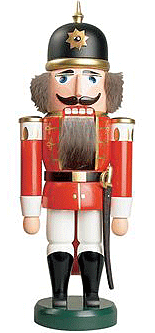 The fierce-looking nutcrackers served a purpose. Though Germans
looked up to authority figures, they were also a bit resentful
of them. The nutcrackers enabled the townspeople to make fun of
them. The soldiers weren't limited to the original Ruritanian
uniforms. They also could wear spiked helmets or dress as
Russian hussars or British grenadiers. And there could be other
fierce characters, including kings and robbers. They later
appeared as more benevolent types from the German culture, such
as night watchmen, chimney sweeps, gnomes, foresters, monks, and
even Rumpelstilzchen. The fierce-looking nutcrackers served a purpose. Though Germans
looked up to authority figures, they were also a bit resentful
of them. The nutcrackers enabled the townspeople to make fun of
them. The soldiers weren't limited to the original Ruritanian
uniforms. They also could wear spiked helmets or dress as
Russian hussars or British grenadiers. And there could be other
fierce characters, including kings and robbers. They later
appeared as more benevolent types from the German culture, such
as night watchmen, chimney sweeps, gnomes, foresters, monks, and
even Rumpelstilzchen.
The Grimm brothers, who collected the famous fairy tales, said
in their dictionary, that a nutcracker was "often in the form of
a misshapen little man, in whose mouth the nut, by means of a
lever or screw, is cracked open.
Literature went on to play a major role in promoting the
nutcracker. The first incidence was in a short story by E.T.A.
Hoffmann, the romantic writer whose split personality inspired
the Jacques Offenbach opera, “Tales of Hoffmann,” first
performed in 1881. His short story, “The Nutcracker and the
Mouse King,” published in 1816, was morbid. Alexander Dumas saw
fairytale possibilities in it which led him to rewrite it as a
children's' story. This in turn caught the eye of a Russian
impresario who commissioned Pyotr Ilich Tchaikovsky to compose
the celebrated Nutcracker Ballet in 1891. In this, a young
girl's nutcracker, given to her as a Christmas present by her
godfather, Drossehmeier, comes to life, does battle with the
evil Mouse King and takes her on a wondrous journey to waltzing
flowers and sugarplum fairies.
The Making of a Nutcracker
There are about 120 steps in the making of a nutcracker, which
explains why even new ones sell for $150 to $250. Pieces of
beech, maple, birch, linden and pine are cut into proper sized
blocks and left to season for up to two years in the open air
under a roof. The first step in the manufacturing process is
done with a lathe. Craftsmen turn the body and head as one
cylindrical piece, with beveled shoulders and chiseled out areas
for the nutcracker and lever. Others turn the arms and legs
separately, fastening them to the body along with the stand.
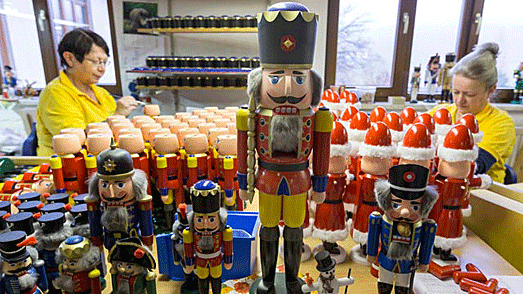
After forming the body, a hand carver gives the figure a nose, a
hat and whatever special features the particular character gets.
Next come several layers of priming, after each of which the
piece must thoroughly dry. Then a painter uses a fine brush to
give the figure its
eyes, moustache, teeth, decorative tunic,
sword and other special features. Again, each coat of paint must
dry before the painter applies another. Then comes the final
assembly,
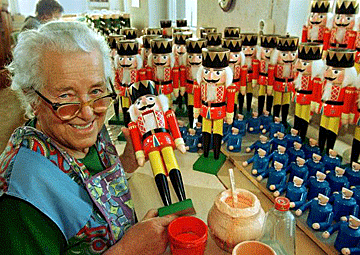 in which another craftsmen adds the lever and glues on
rabbit fur for hair, a beard, and sometimes even a moustache. in which another craftsmen adds the lever and glues on
rabbit fur for hair, a beard, and sometimes even a moustache.
At least that’s how the nutcracker makers of the Erzgebirge do
it. Each firm marks their genuine nutcracker with a stamp
showing a stylized soldier on a hobbyhorse and the slogan ECHT
ERZGEBIRGE HOLZKINST MIT HERZ or “Genuine Erzgebirge wooden art
with heart.”
Variations on the Nutcracker
Theme
There are many variations on the nutcracker theme—mini one-inch
ones, Christmas tree ornaments, six-foot floor models for
stores. Some don’t really crack nuts and the ones that do aren’t
often used for that purpose any more because nuts today mostly
come already shelled. Nutcrackers also appear on posters,
Christmas cards, napkins, place mats, place card holders, coffee
mugs, and neckties.
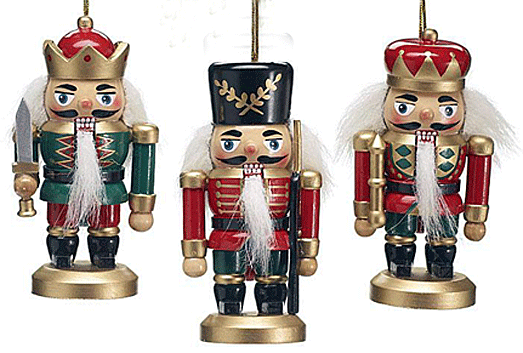
Christian Ulbricht, the present owner of Holzkunst Christian
Ulbricht, was born in Seiffen in 1933. His father, Otto, a
professional turner has established his own business there in
1928. When the communists took over the town, Otto took his
woodworking skills to West Germany, settling in Lauingen,
Bavaria, near Augsburg. Christian took over the business upon
his father’s death in 1968. When Germany reunified, he was able
to reclaim his father’s factory and now operates both, though he
does more of the production in Lauingen.
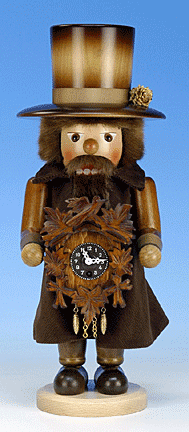 The Steinbach story is similar. The family had worked for
generations in the Erzgebirge, but they, too, escaped to West
Germany after the communists arrived. Christian Steinbach Jr.
Set up shop in 1946 at Hohenhameln, just to the north of the
Harz Mountains. Steinbach, too, now has a factory back in the
Erzgebirge, at Marienberg. The Steinbach story is similar. The family had worked for
generations in the Erzgebirge, but they, too, escaped to West
Germany after the communists arrived. Christian Steinbach Jr.
Set up shop in 1946 at Hohenhameln, just to the north of the
Harz Mountains. Steinbach, too, now has a factory back in the
Erzgebirge, at Marienberg.
Early Fuchtner nutcrackers are among the rarest and most
valuable. Steinbach and Ulbricht have thrown tradition to the
wind since the end of World War II, making nutcrackers depicting
cowboys, clowns, oil sheiks and even a New York fireman. The
figures usually hold something appropriate, such as a wine
goblet, an American flag, or a telescope. There have been
hundreds of such nutcrackers, sometimes in limited editions and
some of them have become quite valuable.
Steinbach also has put out a series based on the Nutcracker
ballet. The figure of Drosselmeier, who holds a miniature
nutcracker, can sell for as high as $3,000, while the Mouse King
gets between $750 and $1,500. Another Steinbach rarity is the
Town Crier.
The whole village of Seiffen becomes a giant "toy store" during
the Christmas season, when an outdoor market is held on each of
the four Saturdays before the holiday.
<
Back to Readers Ask Archives
Next Article > |
